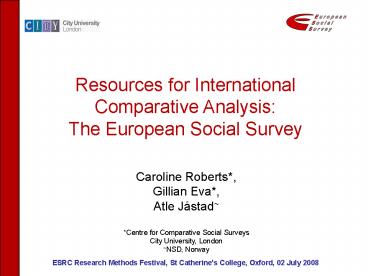Resources for International Comparative Analysis: - PowerPoint PPT Presentation
Title:
Resources for International Comparative Analysis:
Description:
To produce rigorous trend data about changing social values across Europe ... Human Values (using ESS round 1 data): Shalom Schwartz ... – PowerPoint PPT presentation
Number of Views:40
Avg rating:3.0/5.0
Title: Resources for International Comparative Analysis:
1
Resources for International Comparative
Analysis The European Social Survey
Caroline Roberts, Gillian Eva, Atle
Jåstad Centre for Comparative Social
Surveys City University, London NSD, Norway
ESRC Research Methods Festival, St Catherine's
College, Oxford, 02 July 2008
2
About the ESS
- Cross-national biennial time-series
- Academically-driven
- Multiple funding sources
- 18,300 registered data users
Round Fieldwork year No. of countries
1 2002 22
2 2004 26
3 2006 25
4 2008 25 (so far)
3
Three main aims
- To produce rigorous trend data about changing
social values across Europe - To improve the reliability of quantitative
cross-national measurement in Europe - To advance the cause of social indicators and
attitudinal measures
4
Participating countries
Austria France Lithuania Slovenia
Belgium Germany Luxembourg Spain
Bulgaria Greece Netherlands Sweden
Cyprus Hungary Norway Switzerland
Croatia Iceland Poland Turkey
Czech Republic Ireland Portugal UK
Denmark Israel Romania Ukraine
Estonia Italy Russia
Finland Latvia Slovakia
5
The Questionnaire
- Core question topics
- Trust in institutions
- Political engagement
- Socio-political values
- Multi-level governance
- Moral social values
- Social exclusion
- National, ethnic, religious identity
- Well-being, health, security
6
Rotating Modules
- Round 1
- Immigration
- Citizenship, engagement and democracy
- Round 2
- Family, work and well-being
- Economic morality
- Health and care-seeking
- Round 3
- Timing of the life course
- Subjective well-being
- Round 4
- Experiences and expressions of ageism
- Welfare attitudes in Europe
7
Methodological Advances
- Organisational structure
- Translation
- Sampling
- Fieldwork procedures and timing
- Response targets and enhancements
- Progress monitoring
- Contextual and event data
- Methodological research
- Transparency
- Access for all
8
ESS Resources
- For background information documentation
- ESS home website
- www.europeansocialsurvey.org
- For ESS data
- ESS Data Archive website
- http//ess.nsd.uib.no
- For training in data analysis
- ESS EduNet
- http//essedunet.nsd.uib.no
9
ESS Data Archive
- Free immediate access quick registration
- Data documentation organised by round
- Survey documentation including information about
sampling, weighting and population statistics - Fieldwork documents questionnaires showcards,
etc. - Fieldwork summary response rates, fieldwork
dates, sample size, and national deviations - Data download integrated country files
- Contextual data indices including macro
event data - Cumulative data file now available for rounds 1-3
- Online-browsing analysis using Nesstar
Webview - ESS Bibliography
- ESS EduNet
10
Other resources NESSTAR
- NESSTAR
- Online browsing and analysis
- For use with the full ESS datasets or the
specially prepared ESS EduNet data - Options
- 1. Description of study, datafile, variables,
etc. - 2. Table create frequency tables and crosstabs
- 3. Analysis perform regression analysis
- http//nesstar.essedunet.nsd.uib.no/webview/
- http//ess.nsd.uib.no/webview/
11
NESSTAR example table
12
Other resources ESS Bibliography
- ESS Bibliography
- Provides information about publications based on
the European Social Survey - Can search by author, keyword, year, country,
publication type - Authors submit information about their own
publication
13
ESS Bibliography search page
14
Other resources ESS EduNet
- Internet-based analysis training programme aimed
at facilitating and enriching access to empirical
data in the social sciences - The resource is developed for use in higher
education - A hands on introduction to social science data
analysis - Combining theory, data and methodology
- Connect text (written by distinguished
researchers) with data (high quality ESS data)
15
http//essedunet.nsd.uib.no/
16
Topics
Social and Political Trust (using ESS round 1
data) Ken Newton 2 theories of the origin of
social trust, outlines the relationship
between political and social trustHuman Values
(using ESS round 1 data) Shalom Schwartz
Schwartzs theory on human values, shows how
values can be used as both dependent and
independent variablesRegression (using ESS
round 2 data) Odd Gåsdal Hands on
introduction to analysing cross-sectional survey
data using linear regression methodsFamily,
Gender and Work (using ESS round 2 data) Noah
Lewin-Epstein and Haya Stier Different ways in
which survey data are used in comparative
research, uses these to examine the family-work
connection
17
Topics chapter navigation
- Each topic is divided into several chapters
- Each chapter is again divided into several short
pages - Each chapter contains exercises of varying
degrees of difficulty - Chapters take around 1 hour to complete
http//essedunet.nsd.uib.no/
18
(No Transcript)
19
Data
- Statistical Data
- Extracts from the ESS rounds 1 and 2 and a data
set with country level information - Available for online analysis in Nesstar WebView
(with correlation) - Or to download in different formats
- Methodological glossary
- Short description of some key concepts. Each
concept is followed by a link to Wikipedia and an
online statistical textbook
20
Other resources
- About
- Short description of the ESS project and ESS
EduNet
- User guide
- Help pages on technical requirements, NSDstat,
weighting, etc. - An introduction on how to analyse data online - a
useful starting point for those with no
experience in statistical analysis
21
Advantages of ESS EduNet
Closeness to data
Easy to use
Research practice
22
Any Questions?
ess_at_city.ac.uk
- Thank you!































